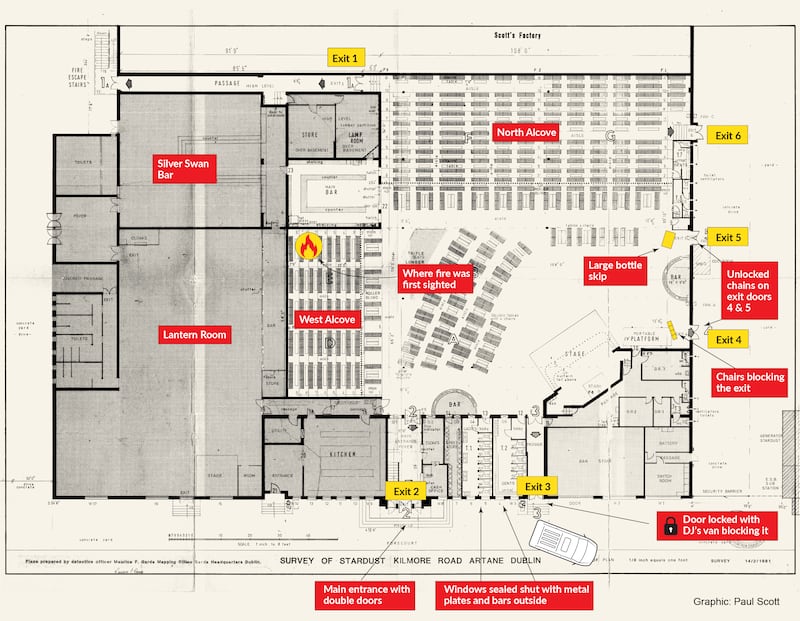The fresh inquests into the 1981 Stardust disaster were ordered by the Attorney General following persistent lobbying by families of the victims of the fatal fire.
Earlier inquests in 1982 were limited to establishing the medical cause of death of the 48 young victims and did not address the cause or spread of the fire or the wider circumstances of each death.
The disaster was separately subject of a tribunal of inquiry, chaired by Mr Justice Ronan Keane, which sat for 122 days and heard from more than 366 witnesses before delivering a detailed report in June 1982 which slammed “recklessly dangerous practices” and safety standards at the nightclub, and made recommendations aimed at avoiding such disasters.
To the dismay of the families, the report also contained a controversial finding the cause of the fire was “probable arson”.
READ MORE
In 2008, following submissions from the Stardust victims committee, the government appointed senior counsel Paul Coffey to examine the case for a renewed inquiry into the fire.
He concluded the tribunal’s finding the fire was probably due to arson was not objectively justifiable on the evidence; that it would not be possible to establish the cause of the fire based on any new evidence available to him at that time; and a fresh inquiry was not in the public interest.
He recommended a change of conclusion concerning the finding of arson should be placed on the public record by the Oireachtas, which was done.
In March 2019, an application was made to then Attorney General Séamus Woulfe by relatives of the deceased for fresh inquests. That was grounded upon evidence which included seven witness statements and commentaries from experts suggesting the determination by the Keane tribunal of the cause and location of the original fire was or might be in error.
In late 2019, the Attorney directed fresh inquests, saying he considered there was “an insufficiency of inquiry as to how the deaths occurred, namely, a failure to sufficiently consider those of the surrounding circumstances that concern the cause or causes of the fire”.
Conducted by Dublin coroner Dr Myra Cullinane, the 2023 inquests ran for 122 days during which the jury heard 90 days of evidence from 373 witnesses.
Unlike the 1982 inquests and the tribunal, the families were better resourced for, and more directly involved in, the 2023-2024 inquests. Five legal teams represented various families with each legal team focusing on a particular issue of concern to all and taking the lead on that issue.
The 2023 inquests involved detailed examination of the circumstances of each individual death, an examination long sought by the families who maintained there remained many unanswered questions in the wake of the 1982 inquests and the tribunal.

While the inquests traversed a lot of the evidential ground covered by the tribunal, the exclusion of arson was significant. The 2023 inquests heard additional expert evidence and the families felt much more involved. The inquests also stood out for setting out the human stories of each individual who died.
In contrast to the 1982 inquests, the jury had five permissible verdicts open to them – accidental death, death by misadventure, unlawful killing, an open verdict or a narrative verdict.
In a judicial review challenge taken in 2022, Eamon Butterly, owner of the Stardust, failed to prevent the coroner potentially including the option of a verdict of unlawful killing.
The High Court’s Mr Justice Charles Meenan said it was for the coroner, having heard the evidence, to direct the jury at the close of the inquests on the permissible verdicts.
An inquest, he said, is an inquisitorial fact-finding hearing to establish the facts concerning the who, how, when, where and circumstances of a person’s death.
The Coroners Acts prohibit questions of civil or criminal liability being considered/investigated and verdicts censuring/exonerating a person, the judge said, but do not prevent an inquest establishing the facts concerning circumstances of a death even though those facts may, in another forum, ultimately be relevant to issues of civil or criminal liability.
In appropriate circumstances, an inquest may return a verdict of unlawful killing but only where no person, or persons, is identified or identifiable, he said.
The inquests have highlighted some structural weaknesses in Ireland’s system of inquests in their ability to conform with Article 2 of the European Convention on Human Rights, which requires each person’s right to life shall be protected by law.
Recommendations for coronial reform by the Coroners Review Group and others led to the Coroners Bill 2005, succeeded by the Coroners Bill 2007, but the latter has not been enacted. The Irish Human Rights and Equality Commission has expressed concern the State has yet to enact reform in line with its obligations under Article 2.
- Join us for The Irish Times Inside Politics podcast live in Belfast on April 10th
- Sign up for push alerts and have the best news, analysis and comment delivered directly to your phone
- Find The Irish Times on WhatsApp and stay up to date












